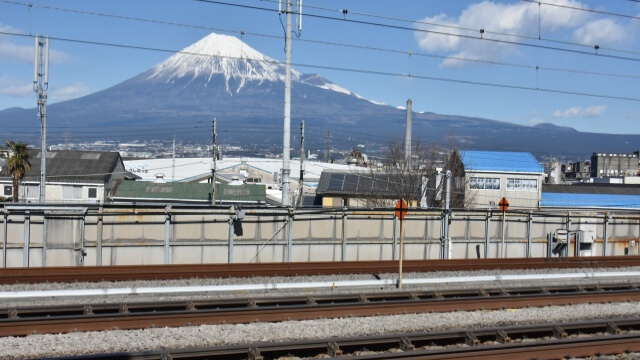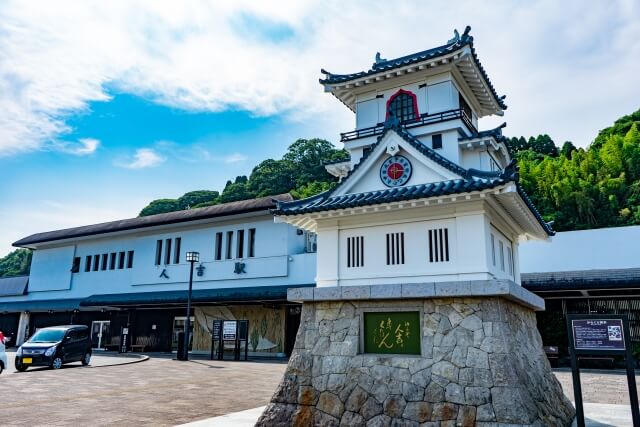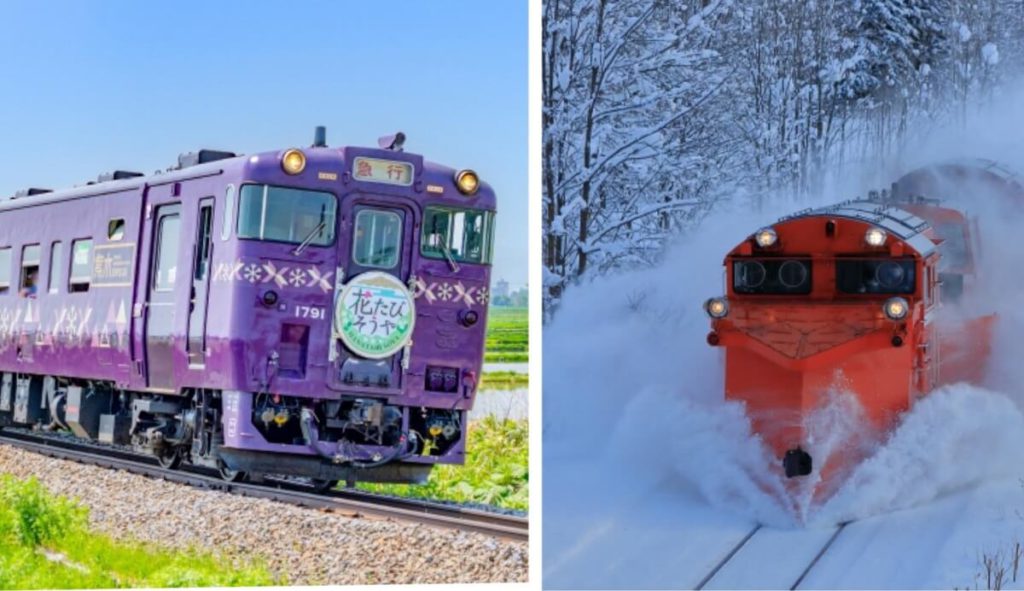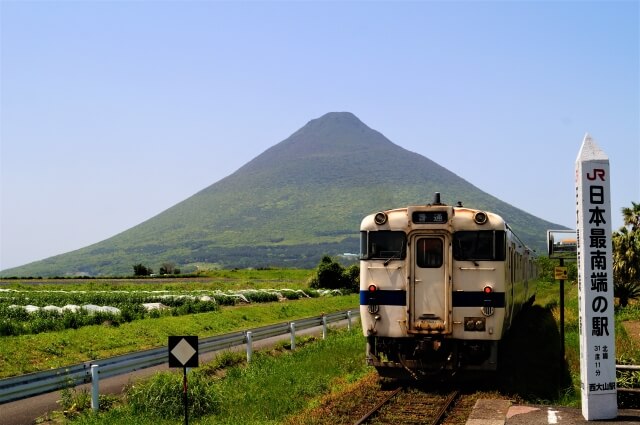Hello, it’s great to see you again. This will be a continuation from part 1. In this section, I’ll be introducing some more interesting stations and railways. Then, please accompany me as we discover more lovely stations to visit. All aboard!
Stations that are close to Mt. Fuji
When Japanese people talk about a magnificent view, the first place they mention is Mt. Fuji. It always attracts people and is considered to be the main symbol of Japan, therefore, it’s worth seeing at least once while you are in Japan.
The easiest way to visit Mt. Fuji is by taking the Fujikyu Railway (富士急行). The train runs between Otsuki Station (大月駅) and Kawaguchiko Station (河口湖駅). Otsuki, which is the first station, connects to the JR Chuo Line (中央線), so it’s an easy trip from Shinjuku Station or Tokyo Station.
Along this line, you can enjoy a breathtaking view of Mt. Fuji from different angles. This is the perfect opportunity to take some wonderful pictures or to grab a coffee and enjoy the scenery at your own pace.


You might know, you can see Mt. Fuji from the window of a Shinkansen in between Shizuoka (静岡) and Atami (熱海), but the best spot is from Shin-Fuji (新富士) Station. In my opinion, the view from Mishima (三島) Station might be in second place.
There is a chance depending on the driver that they will announce to the passengers when they are passing or just before reaching Mt. Fuji. Try not to miss it.


Enjoy hot springs at the station
As you know, hot springs have been popular since ancient times. Have you ever seen a foot spa in a hot spring town? I’ll introduce some hot spring facilities that are situated within the train station.
First, Hottoyuda (ほっとゆだ) Station is located in Iwate and is operated by the JR Kitakami Line. The area is referred to as Yudanaka hot spring village (湯田中温泉峡) and is surrounded by an abundance of nature. Surprisingly, the station has a hot spring on the platform. You can take a bath whether you take the train or not. Do you think that it’s a good way to kill time while waiting for the next train?

Next, let’s move on to Mizunuma (水沼) Station which is operated by the Watarase Keikoku Railway (わたらせ渓谷鉄道). Despite the fact that it’s unmanned, they run a hot spring within the station’s building. It’s a good opportunity to take a day trip to enjoy some local delicacies and relax in the hot spring. I’ll be going into a little more detail about this railway in a later section.

Furthermore, there are major stations which have hot springs.
Onagawa (女川) Station is located in Miyagi and is operated by the East JR Ishinomaki Line. The station building was destroyed by Tsunami in 2011. However, they reopened with the restoration of the entire Ishinomaki Line in 2015. The new building provides a public bathing facility which is called Yu-poppo.

What’s more, I’m going to talk about Takahata (高畠) Station which looks like a lovely castle. It’s located in Yamagata and on the East JR Ohu Main Line (奥羽本線), also it connects to the Yamagata shinkansen. You can come into the hot spring in front of the ticket gate.

The Revival of the Locomotive!
Why not experience riding a steam locomotive? In the earlier days, the steam locomotive was a mainstream of the railway enterprise, but as time went by, they gradually disappeared in favor of electric trains. However, some railway companies decided to restore the services of these locomotives. Let’s take a look at each of them in a bit of detail.
The SL, or steam locomotive Hitoyoshi (人吉) had been running within Kyushu for a 100 years and left a remarkable impact on the history of pre-modern transportation.
In 2009, the SL Hitoyoshi was revived and started running between Kumamoto (熊本) and Hitoyoshi Station. The landscape along Kuma River (球磨川) is amazing and passengers enjoyed watching the view. Unfortunately, Hitoyoshi Station was hit by heavy rain and was forced to close temporarily in 2021. For that reason, SL Hitoyoshi ended up running on a different route between Kumamoto and Tosu (鳥栖) Station. However, this popular locomotive will be retired from work in March of 2024.
I would like to say thank you and great job!


The Mooka (真岡) Railway runs between Shimodate (下館) Station in Ibaraki and Motegi (茂木) Station in Tochigi. They offer a steam locomotive running on limited weekends and national holidays. However, you might want to get a ticket beforehand because the SL Mooka is extremely popular among railroad fans.
Mooka Station was designed after steam locomotives and has many facilities for tourists to use such as restaurants, rest spaces, and rental cycle shop. There is also a rail yard and SL museum by the station for people to enjoy.


If you are interested in steam locomotives, why don’t you visit the Kyoto Railway Museum? They exhibit a variety of trains and offer educational events guided by the museum staff. You will learn a lot about railway culture and history in Japan.

Kyoto Railway Museum website
https://www.kyotorailwaymuseum.jp/sp/en/about/
Enjoy flower viewing from the train window?
Spring in Japan means cherry blossom season. Here are some railways that you can enjoy some flower viewing from.
There are two railways: Kominato Railway (小湊鐵道) and Isumi Railway (いすみ鉄道) in Chiba which run in the center of the prefecture. The Kominato railway runs between JR Goi (五井) Station and Kazusa-Nakano (上総中野) Station and the Isumi railway continues on from Kazusa-Nakano to Ohara (大原) Station. Both of them are local train lines, but the rural landscape from the window is really majestic. A combination of cherry blossoms and canola flowers creates a beautiful atmosphere that attracts people and takes them back to the days of their rural Japanese hometown.



Now, let’s return back to the previously mentioned routes. Watarase Keikoku Railway runs between Kiryu City in Gunma and Nikko City in Tochigi. Passing through the Watarase Valley, it provides passengers with a great view anytime of the year. Moreover, the peach blossoms in full bloom during spring are particularly impressive. There are a few more noteworthy things that you can see: fresh leaves, cherry blossoms, and autumn leaves depending on the season.

From North to South: Your Last Stop
Our trip is coming to an end. Lastly, I’ll introduce the farthest train stations in the country.
Northernmost station is Wakkanai (稚内) Station in Hokkaido. The station faces the Sea of Japan on the westside and the Sea of Okhotsk to the east.
The railway is operated by JR Soya Main Line (宗谷本線) and begins at Asahikawa (旭川) Station in the center of Hokkaido and reaches to Wakkanai Station. The great scenery that jumps into your eyes tells you about the beauty of short summers and the harshness of winter.


On the contrary, southernmost station is Nishioyama (西大山) Station which is located in Kagoshima. It’s operated by the JR Kyushu Ibusuki Makurazaki (指宿枕崎) Line. The area is famous for its hot spring and the climate is mild throughout the year. Standing tall, Mt. Kaimon looks absolutely beautiful. Would you like to take a slow trip to this area?

If you have a chance, please check out Part 1.
Conclusion
Thank you for taking my tour of visiting some unique stations. Did you find anything interesting? I urge you to have a closer look at each station, and you might find some surprising point that is hidden away. Then, it’s about time to depart. Have a nice trip!
Brand Ambassador of kyoto Denim company, Kimono dresser, Japanese flower arrangement instructor I was born and raised in Osaka, I know this area like my backyard. I’d like to introduce Japanese culture and good points to someone from overseas. That’why I study English every day. Please feel free to ask me if you need anything.





 HTJ has a YouTube page! Check it out
HTJ has a YouTube page! Check it out